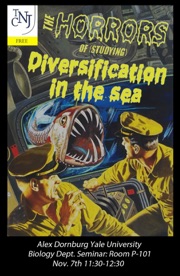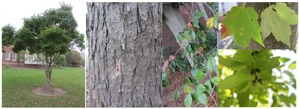This semester marked the official start of the tree inventory of TCNJ’s campus. This effort, led by Jesse Mendillo, seeks to document all the trees on our campus. For each tree we record its location, make notes about its habit and growth, collect material to make an herbarium sample, and collect leaf material to dry in silica for future molecular work.

Fall 2013
Office - 117 Biology Building
Lab - 236 Biology Building
Phone - 609.771.2672
Email - clementw at tcnj.edu

New members
Clem Lab is excited to welcome Patrick Gallagher and TJ Stammer to the lab. Patrick brings his love of all things citrus, particularly limes (check out his lime blog in The Signal), in his desire to learn more about plant evolution. TJ brings a knack for bioinformatics and all things computer programming related in his start to exploring the world of evolution and plants. We are excited to have both with us and look forward to all the good things to come!
Check out the latest Viburnum publication:
David Chatelet, Wendy Clement, Lawren Sack, Erika Edwards, and Michael Donoghue. 2013. The evolution of photosynthesis anatomy in Viburnum (Adoxaceae). International Journal of Plant Sciences. 174(9): 1277-1291.
New publication!
Fall visitors & seminars
From left to right: Amanda Goble (’16), Jesse Mendillo (’16), Nitya Chitravanshi (’14), Syndi Barish (’16), Alanna Cohen (’15), and Wendy Clement.

News Highlights
As part of our efforts to collect and document plant diversity on our beautiful campus, the TCNJ herbarium is now part of the Consortium of Northeastern Herbaria (CNH) and has submitted 100 digital collections from the TCNJ Campus Tree Inventory Project that are now publicly available.
Introducing: The TCNJ Herbarium
This fall we welcomed Alex Dornburg, a PhD candidate in the Ecology and Evolutionary Biology Department at Yale University. He gave an awesome talk demonstrating the power of a phylogenetic approach to studying evolutionary questions at many different scales.
Wendy also gave a School of Science Colloquium talk discussing how we use trees to study biodiversity. In particular she focused on how we can use phylogeny to identify and name groups of organisms based on evolutionary relationships as opposed to overall similarity in morphological features. This approach of providing phylogenetic names and definitions (according to Phylocode) to groups of organisms represents an alternate approach to classification compared to the more common ranked based Linnean system.

The samples collected are part of our TCNJ herbarium. As part of this new collection effort, we are now a registered member of the Consortium of the Herbarium of the Northeast (CNH). In addition to having a physical herbarium located in the Biology Building at TCNJ, all of our collections have been digitized are are publicly available on the CNH website. In addition to an image of the herbarium specimen, we have also provided photos of the living plant so that viewers can see parts of the plant not captured by herbarium specimens such as bark and growth form.

